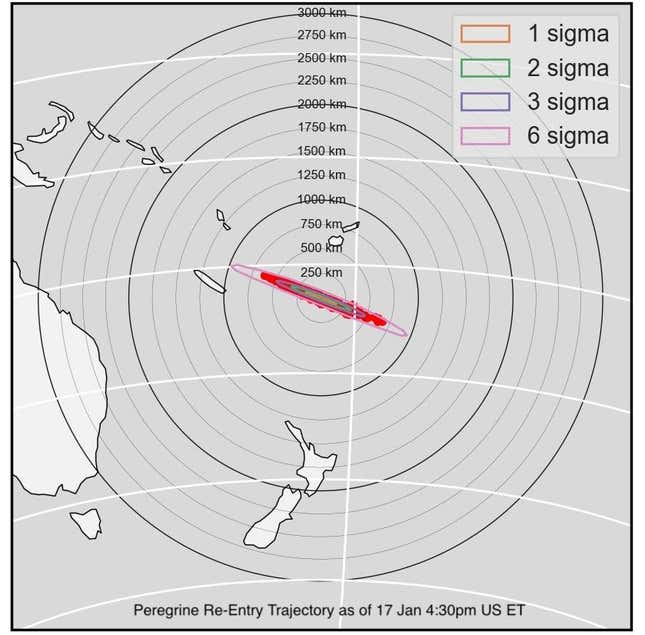The saga of Peregrine is coming to a tragic end, with the lunar lander scheduled for reentry through Earth’s atmosphere after failing to touch down on the Moon.
After 10 days of journeying through space, Astrobotic has positioned its lunar lander on a trajectory towards Earth to perform a controlled re-entry over a remote area of the South Pacific on Thursday, January 18 around 4:00 p.m. ET, the company wrote in an update.
Peregrine launched on January 8 on board United Launch Alliance’s Vulcan Centaur rocket, with plans to land on the Moon in late February. However, the spacecraft experienced a propulsion anomaly early on that destroyed any possibility of a soft landing on the Moon. The lander began to lose propellant at a critical rate, which may have been caused by a faulty valve.
The 2,829-pound (1,283-kilogram) spacecraft is carrying 24 different payloads from three national space agencies, with 11 payloads from NASA alone, as well as a host of other payloads from private companies. Among the payloads that were supposed to be deployed in space and on the Moon are the cremated remains and DNA of nearly 200 individuals. Fortunately, the companies responsible for the other-worldly memorial services pack a symbolic portion of people’s remains just in case things go wrong.

Although the spacecraft is still operational, Astrobotic has made the decision to dispose of Peregrine in a responsible way rather than adding to the already critical issue of space debris. “The team has been continuously monitoring our re-entry analysis with NASA, which indicates a re-entry path over the indicated area below, with no anticipated hazards,” Astrobotic wrote in its statement. “A safe re-entry is our top priority.”
Peregrine is expected to burn up in the atmosphere during reentry, but it’s not impossible that some debris might reach the surface. Astrobotic, with NASA participating, will host a press conference at 1:00 p.m. on Friday, January 19, during which time we hope to learn more about the doomed mission, the reentry procedure, and how it all went down.
In order to position the spacecraft on an Earth-bound trajectory, the company carried out a two-step maneuver. The initial step involved a main engine burn, but due to the anomaly with Peregrine, the team couldn’t operate the engine as usual. Instead, they carried out a series of 23 small engine burns to change the spacecraft’s trajectory. Afterwards, the team used the spacecraft’s propellant leak to its advantage, adjusting Peregrine’s attitude, or orientation, so that the force induced by the leaking propellant shifted its position towards the South Pacific Ocean.
The Pacific Ocean often serves as a spacecraft graveyard, with space agencies dumping their defunct missions in the remote waters to avoid falling onto habitable areas.
Peregrine is part of NASA’s Commercial Lunar Payload Services (CLPS) initiative, which is meant to help the space agency in its quest to return humans to the Moon and make it a sustainable place for long-term human presence. It was also meant to usher in a new era for private companies by granting them greater access to the lunar surface, Astrobotic was hoping to become the first private company to land on the Moon. Space is tricky business, however, and the race for private companies to land on the dusty surface of the Moon is still on.
For more spaceflight in your life, follow us on X (formerly Twitter) and bookmark Gizmodo’s dedicated Spaceflight page.

